Evolution of NIKONOS
- Development of All-Weather Camera NIKONOS
- Introduction of NIKONOS
- Evolution of NIKONOS
- Introduction of the world first underwater AF SRL camera NIKONOS RS AF
- Summary
Development of All-Weather Camera NIKONOS

In May 1961, LA SPIROTECHNIQUE, a French offshore machinery development company, developed a new type of 135-format watertight camera, the Calypso (named for a nymph in Greek mythology), and contacted us through what was then Teikoku Sanso KK (presently Teisan Co.) about commercial production and marketing.
In 1956 we developed an underwater housing to hold the Nikon S2 for underwater photography, and introduced the underwater camera in May under the brand name of Nikon Marine. Then, we made improvements by combining the bodies of SP and S3 in addition to the body of S2 (No.66141001 and later) with the W-Nikkor 3.5 cm f/2.5 and W-Nikkor 2.8 cm f/3.5 lenses, to enable us to use the W-Nikkor 3.5 cm f/1.8 lens. However, the housing-based Nikon Marine was heavy and expensive, and quite different from the Calypso in the technological and functional aspects as well as in marketability.
Realizing that this product involved original ideas, had sufficiently high performance, and its export potential was promising with higher marketability, we formed a technical tie-up with LA SPIROTECHNIQUE in January 1962, and acquired the exclusive production rights and also the exclusive sales rights except in France and the EEC (the European Economic Community of that time).
The underwater camera offered a variety of features including those listed below, with the aid of complete air-tightness provided by the O-ring and the perfect waterproofing in the die-cast sections.
- 1.Compact and lightweight, thereby ensuring easy and simple operation,
- 2.As an all-weather camera, the camera can be used not only underwater (water-resistant to a water depth of 50 m) but on land as well
- 3.More cost-effective compared to the conventional housing-based design.
Specifications of NIKONOS
| Type of camera | 35 mm focal-plane shutter type underwater camera |
|---|---|
| Depth at which it is water pressure-resistant | 50 m |
| Lens mount | NIKONOS mount |
| Viewfinder | Albada type with built-in bright frame for use with standard 35 mm lens; parallax compensation marks provided; 0.63x magnification |
| Shutter | Vertical-travel metal focal-plane shutter; B (for bulb), 1/30 sec., 1/60 sec., 1/125 sec., 1/250 sec., and 1/500 sec. |
| Film advance | Lever type; Film advance and shutter setting combined in one; additive type frame counter provided |
| Film rewind | Pull-out and knob type |
| Dimensions (W x H x D) | Approx. 125 x 97 x 68 mm (with 35 mm F2.5 lens) |
| Weight (on land) | Approx. 700 g (with 35 mm F2.5 lens) |
Introduction of NIKONOS
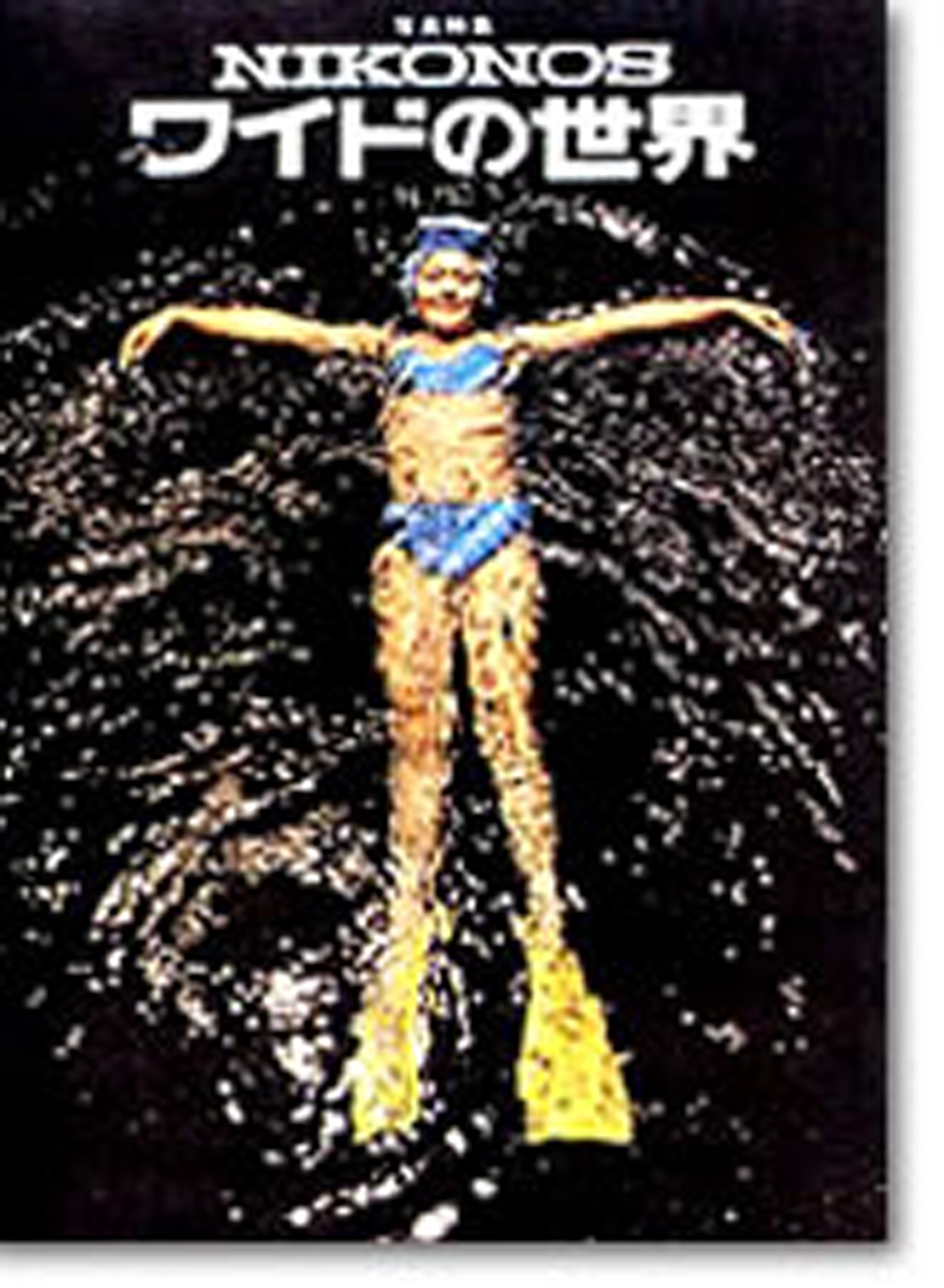
We at Nikon considered this camera as an All-Weather Camera for its highly water-tight, pressure-resistant, and corrosion-resistant properties and other durable mechanisms not achieved by any other cameras, and decided to sell it under the brand name of NIKONOS.
W NIKKOR 35 mm f/2.5 for use both underwater and in air, and a little later, underwater-specific wide-angle lens, U·W NIKKOR 28 mm f/3.5 were made available. In addition, flashguns essential to underwater color photography were also made available.
The front waterproof glass of the 35 mm f/2.5 lens was flat, while the underwater-specific 28 mm f/3.5 lens had a biconvex lens and this waterproof front lens and water combination formed a single lens to help correct any distortion and/or chromatic aberration in the water.
In March 1963, prior to the formal announcement of the introduction, we entered NIKONOS in the 8th Photokina as a new product, and the idea of hanging the NIKONOS in a aquarium in which goldfish were swimming attracted the attention of visitors.
The camera was put on sale domestically in Japan in August 1963 at a consumer price of 28,500 yen (with the 35 mm f/2.5 lens), and was favorably received as an unprecedented handy watertight camera in a variety of sectors including academic research, underwater photography, oceanic research, civil engineering, and construction. In the first half of the following year, 1964, the statistics on sales volume of 35 mm cameras by model showed that this model achieved the average monthly sales volume of 1,300, next to Nikon F. In August 1966, a special issue of World of Wide was published, carrying the photographs taken by photographers active at the forefront using the NIKONOS regularly, and was distributed to Nikkor Club members, camera shops and other parties and individuals involved in publicizing the camera's characteristics.
Evolution of NIKONOS
NIKONOS II
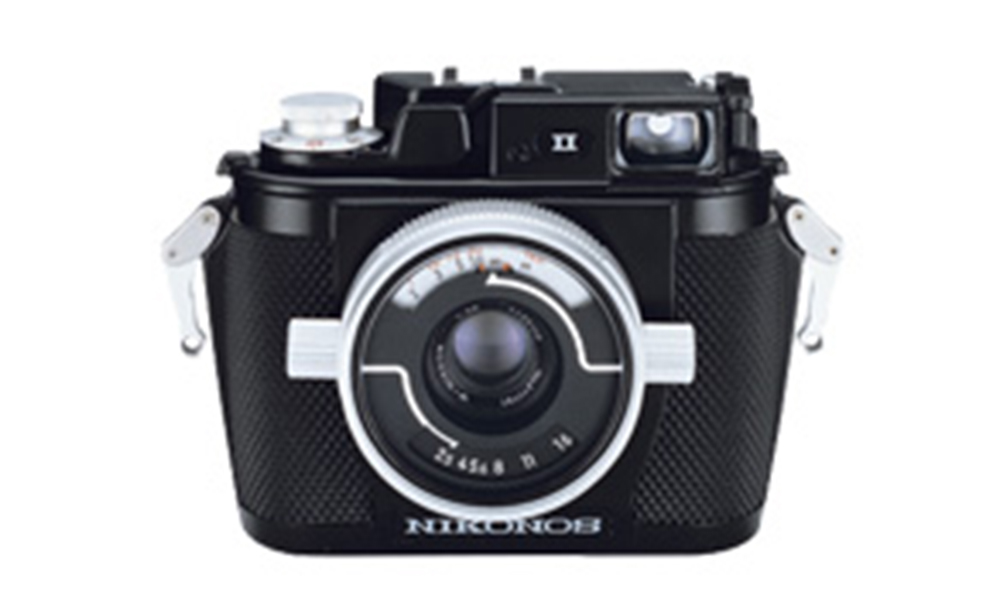
The well-received NIKONOS then evolved into the successor NIKONOS II, which went on sale in 1968 at 23,000 yen. Since then, the original NIKONOS has been known as NIKONOS (version I).
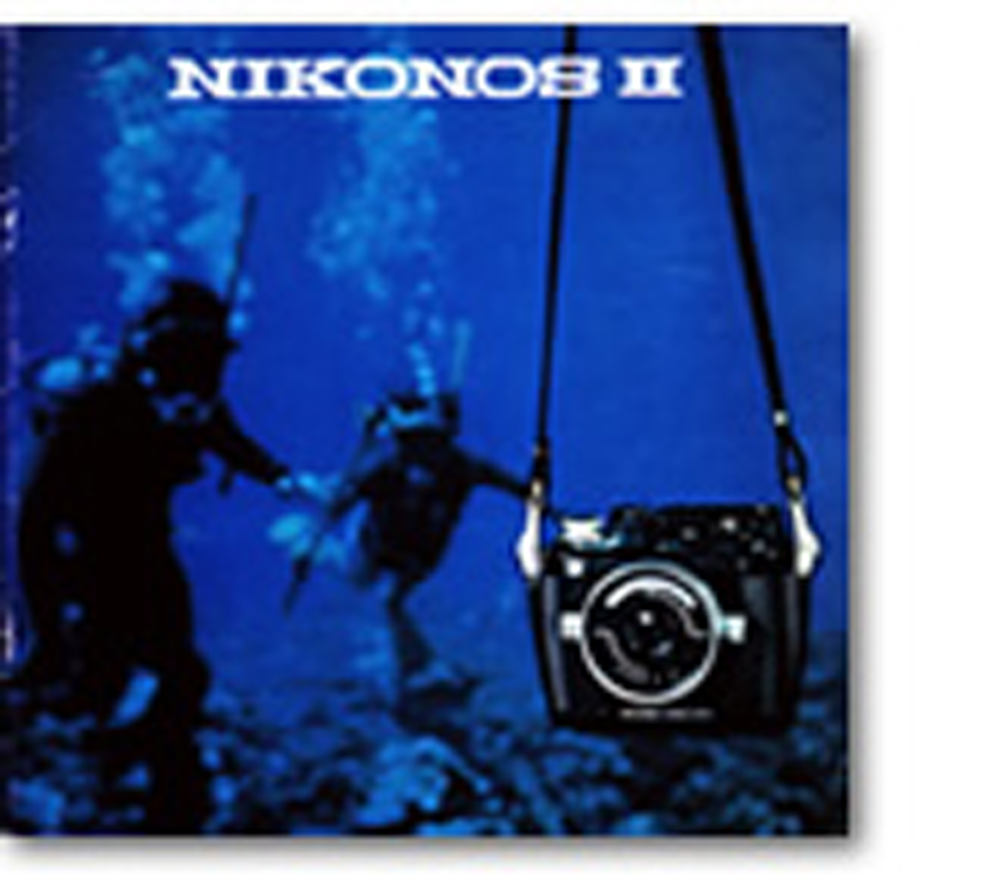
NIKONOS II had a few major improvements as follows: the film wind-up mechanism was changed to a retractable crank from a knob to accelerate the film rewinding; the film pressure plate was improved to a hinged design to facilitate the exchanging of films thanks to a pop-up pressure plate; and the logotype II was inscribed next to the viewfinder window to represent the version II.
Specifications of NIKONOS II
| Type of camera | 35 mm focal-plane shutter type underwater camera |
|---|---|
| Depth at which it is water pressure-resistant | 50 m |
| Lens mount | NIKONOS mount |
| Viewfinder | Albada type with built-in bright frame for use with standard 35 mm lens; parallax compensation marks provided; 0.63x magnification |
| Shutter | Vertical-travel metal focal-plane shutter; B (for bulb), 1/30 sec., 1/60 sec., 1/125 sec., 1/250 sec., and 1/500 sec. |
| Film advance | Lever type; Film advance and shutter setting combined in one action; additive type frame counter provided |
| Film rewind | Pull-out type with film rewind crank |
| Dimensions (W x H x D) | Approx. 129 x 99 x 47 mm (Body alone) |
| Weight (on land) | Approx. 655 g (with 35 mm F2.5 lens), 495 g (Body alone) |
NIKONOS III
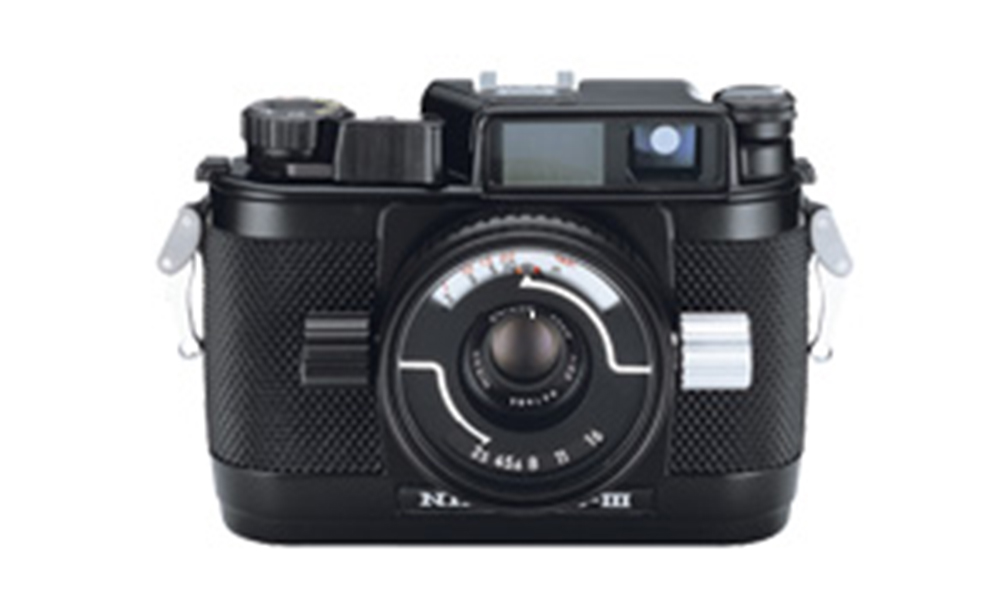
Later in 1975, NIKONOS III went on sale at 45,000 yen, featuring the further improved durability and operability of NIKONOS II.
The version III went through some major improvements to its predecessors as follows: a sprocket was adopted for film wind-up, when the wind-up amount in predecessors I and II had to be adjusted by gradually decreasing the angle of rotation of the spool with every frame. This achieved equal frame-to-frame spacings on a roll of film. The frame counter was relocated to the top of camera from the bottom of the body outer casing for more convenient reading. The viewfinder was modified to the illuminating window-type bright frame to provide a brighter field of view and a crisper, clearer frame. And an additional frame for 80 mm lenses was incorporated. Moreover, special considerations were made as follows: the film holding spool was improved to contain two grooves for easier film loading; the flash sync connector was improved; and the hinged pressure plate adopted first in version II was modified to open in the downward direction.

The body became larger in size due to the adoption of sprockets and the illuminating window-type viewfinder. However, the film advance lever was modified to a larger size, and the film rewind crank and shutter release button were redesigned to fit the camera and ensure easier operation even with gloved fingers. The versions I and II were a unique spindle-shaped design in appearance which was said to be resistant to external pressures. The version III inherited the spindle-shaped appearance, though it was getting closer to a box-shaped camera. The logo mark of NIKONOS III was moved under the lens mount of the body outer casing.
Specifications of NIKONOS III
| Type of camera | 35 mm focal-plane shutter type underwater camera |
|---|---|
| Depth at which it is water pressure-resistant | 50 m |
| Lens mount | NIKONOS mount |
| Viewfinder | Illuminating window-type bright frame (for use with 35 mm/80 mm lenses); Approx. 0.61x magnification; finder coverage approx. 84%; parallax compensation frames provided |
| Dimensions (W x H x D) | Approx. 144 x 99 x 47 mm (Body alone) |
| Weight (on land) | Approx. 620 g (Body alone), 780 g (with 35 mm F2.5 lens) |
NIKONOS IV-A
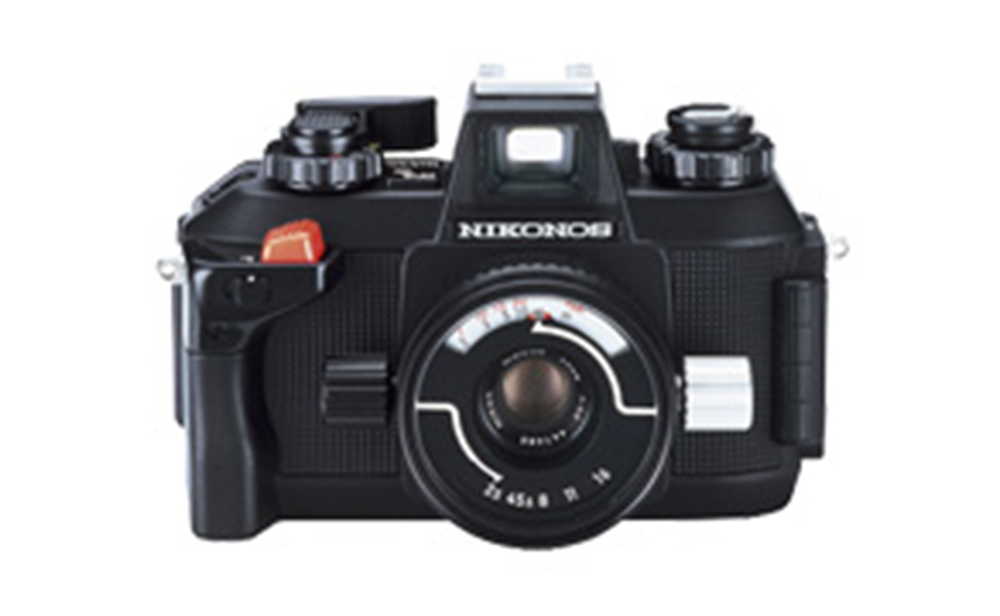
NIKONOS I, II and III are modified or improved versions of Calypso, whereas NIKONOS IV-A is regarded as a Nikon's completely original model developed and designed based on Nikon's proprietary concepts. This model was placed on the market in July 1980 at 54,500 yen. It offered a variety of capabilities and its key features are discussed below.
1. TTL exposure meter and aperture-priority AE control mechanism
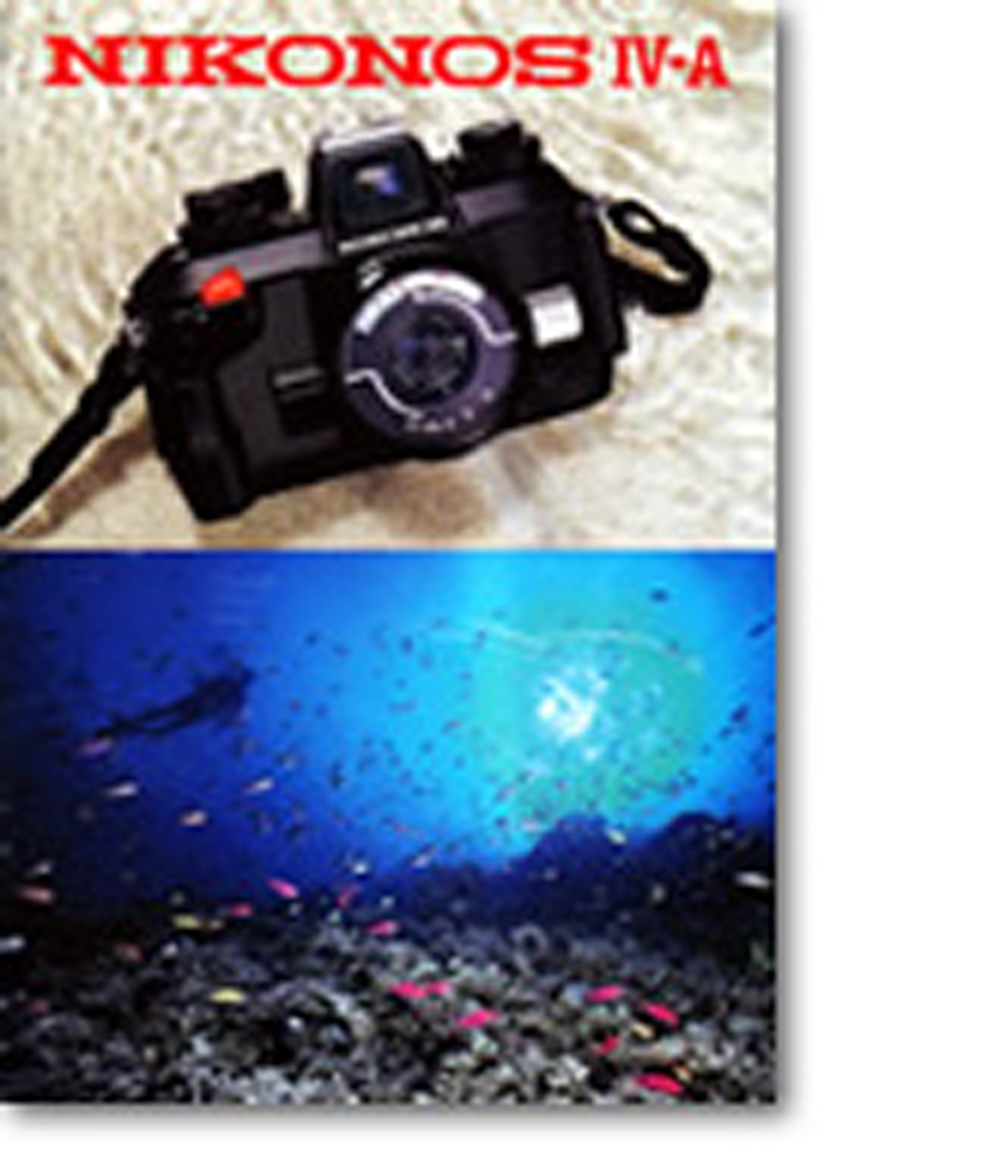
At that time, aperture-priority and other automatic exposure (AE) control systems came into common use among the single-lens reflex (SLR) cameras for use on land, and the IV-A also adopted the AE control mechanism. This model was equipped with the automatic exposure control with through-the-lens (TTL), center-weighted, exposure metering of aperture-priority in order to ensure correct exposure by taking into account the brightness of the edges of the image field while focusing on the center of the image plane. In order to realize the exposure metering system, a reflector was incorporated in front of the shutter blade, working in synchronization with the shutter blade. The reflector reflects the light after it passes through the lens and directs it towards the light-receiving element SPD for exposure metering, and correct exposure is determined based on the amount of light sensed at the SPD. In water, it is difficult to determine optimum exposure, but the aperture-priority AE was well received by many photographers since it could offer an accurate exposure value simply by selecting an aperture.
2. Electronically controlled shutter
In response to the selection of aperture-priority AE, an electronically controlled shutter was adopted in place of the conventional mechanical shutter. The highly accurate electronic shutter control provided automatically variable shutter speeds from 30 up to 1/1000 seconds. In addition, the most advanced electronic technologies of the time, including an LED indicator in the viewfinder, were incorporated. Since the electronic shutter fails to work when the batteries become exhausted, the mechanical shutter release of 1/90 sec. was incorporated for backup purposes, and the setting of B (for bulb) was also adopted for a wide variety of applications.
3. Hinged-type open-and-close camera back
The predecessors I, II and III were designed with an outer casing which was vertically disengaged from the body frame. However, the model IV-A was designed with a hinged-type open-and-close camera back, similarly to that of land-use cameras, for easy loading of films.
4. Significantly easier operation
The predecessors I, II and III were designed without a shutter release button, but had a mechanism in which the shutter was released when the film advance lever was pushed inward. This design was adopted to ensure resistance to water pressures and minimize the necessity for watertight areas of movable parts. The model IV-A was equipped with a shutter release button and a film advance lever similarly to typical cameras for use on land, which provided greater ease of operation during photography. In addition, the inverted Galilean-type Albada viewfinder with an LED display for exposure marking was well received for its ease of use since correct exposure could be obtained simply by confirming that the display was ON. Furthermore, the Speedlight SB-101 designed specifically for NIKONOS provided automatic flash sync. control when used with the attached sensor unit SU-101. When the Speedlight was fully charged, it could be identified by the "ready-light" inside the viewfinder, which helped achieve a level of convenience and ease of operation similar to that of land-use cameras.
Specifications of NIKONOS IV-A
| Type of camera | Electronically controlled 35 mm focal-plane shutter type underwater camera |
|---|---|
| Depth at which it is water pressure-resistant | 50 m |
| Lens mount | NIKONOS mount |
| Viewfinder | Inverted Galilean-type Albada finder (for use with standard 35 mm lens); Approx. 0.55x magnification; finder coverage approx. 85%; parallax compensation marks provided |
| Indications within finder | LED over- and under-exposure warning arrows LED glows to indicate correct exposure. LED blinks to warn exposure is outside lower or upper limit for shutter sync. LED ready-light symbol LED glows to indicate that the dedicated Speedlight is fully charged. |
| Exposure metering | TTL center-weighted stop-down metering; SPD (silicon photo diode) used as light receiving element |
| Metering range | EV 8 to 19 (ISO 100) |
| Film speed range | ISO 25 to 1600 |
| Shutter | Electronically controlled vertical-travel metal focal-plane shutter |
| Shutter speed | A (Automatically controlled, stepless from 1/30 to 1/1000 sec.) M (Mechanically controlled at 1/90 sec.) B (Mechanically controlled at B for bulb) |
| Flash synchronization | X-sync only: Synchronizes at M (1/90 sec.) with the Speedlights; Shutter speed automatically switches to 1/90 sec. even in the A (Auto) mode when any dedicated Speedlight is used. |
| Camera back | Hinged type |
| Camera back opening and closing | Buckle type |
| Power source | Two (2) 1.55 V SR44 silver-oxide batteries |
| Exposure meter switch | Exposure indication LED lights up when the shutter release button is pressed halfway down; Batteries are exhausted when the LED fails to light up, replace with fresh ones. The switch will be set to OFF approx. 20 seconds after the shutter release button is released. |
| Dimensions (W x H x D) | Approx. 149 x 99 x 58 mm (Body alone), Approx. 149 x 99 x 74 mm (with 35 mm F2.5 lens) |
| Weight (in air) | Approx. 740 g (Body alone), Approx. 900 g (with 35 mm F2.5 lens) |
NIKONOS V
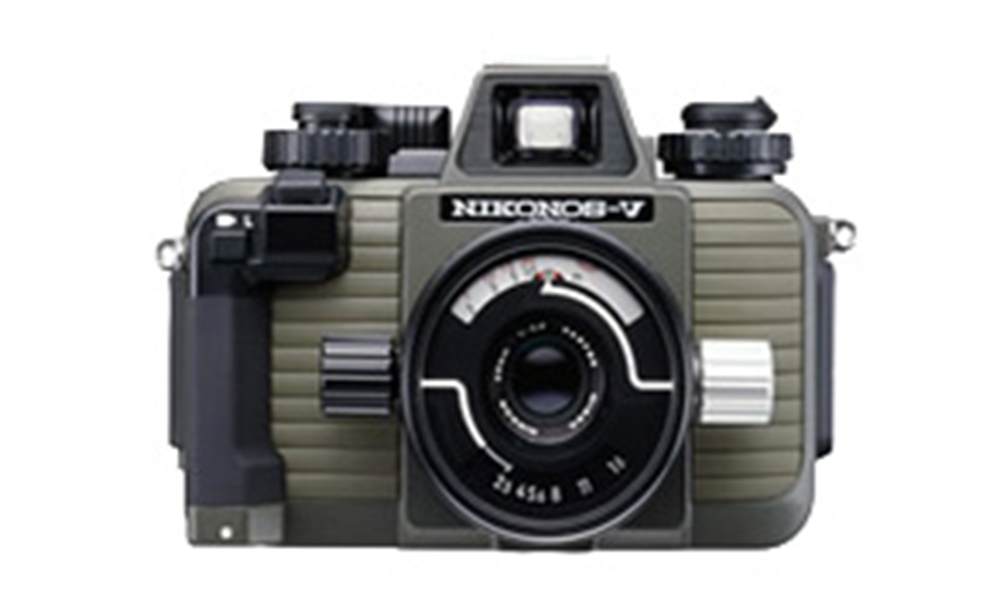

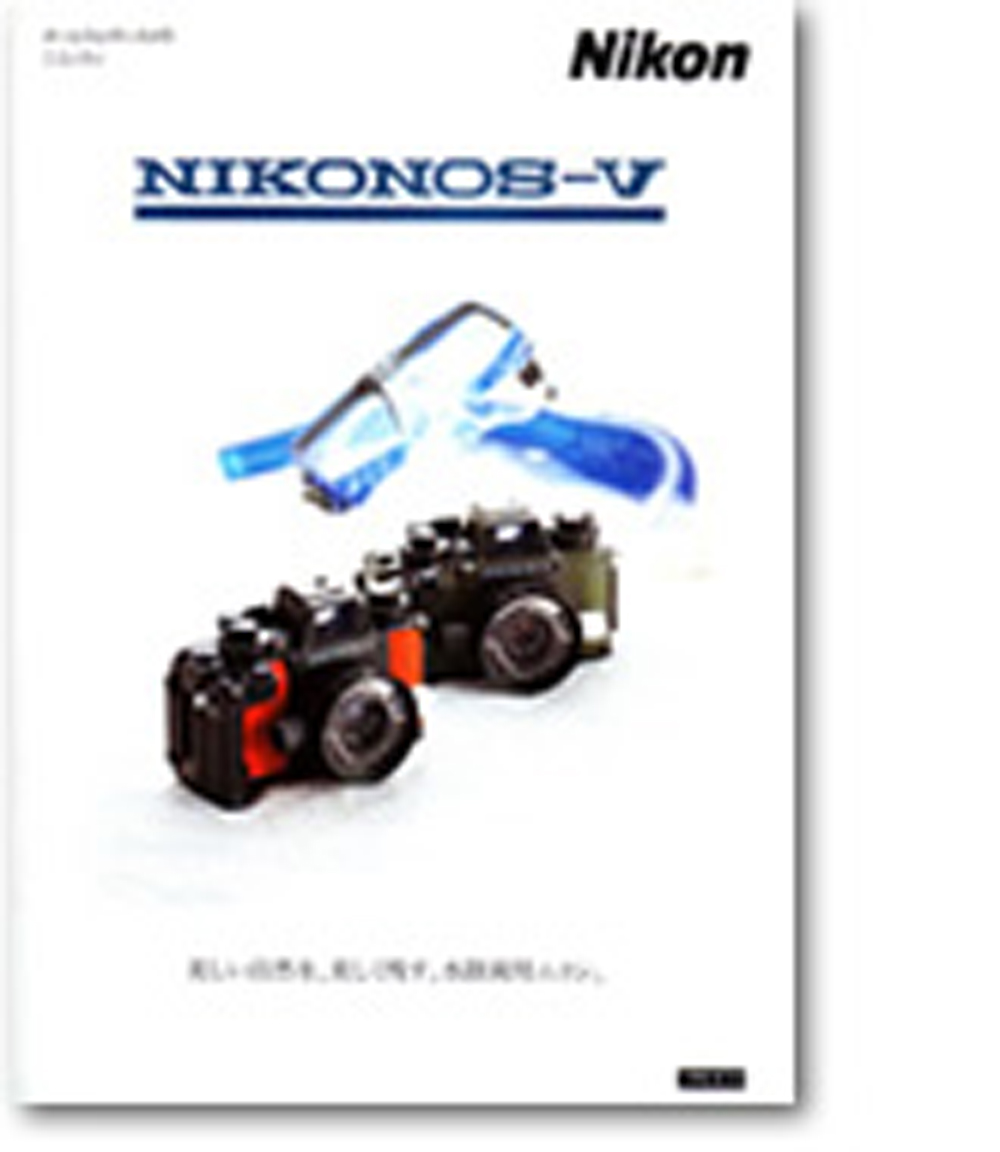
The model IV-A became a breakthrough camera for its capability to provide automatic exposure control underwater with the aperture-priority AE. In practice, however, the shooting mode was limited to aperture-priority; then, the addition of the manual mode was requested to permit optional selection of shutter speeds. In response to the request, the NIKONOS V incorporated the manual mode in addition to the aperture-priority AE. In addition, the flash control of Speedlights used with IV-A was based on an external sensor; the V made possible the automatic TTL flash control by using the specifically designed Speedlight models including SB-102 and 103. The model V came out in April 1984 at 73,000 yen with a significant evolution in automatic control of exposure and Speedlight. This model also adopted a mechanical shutter to offer a backup shutter speed of 1/90 sec. in the event of a dead battery, and a Bulb setting, as in the case of IV-A. This model was available with a light orange and green body finish colors, which was a somewhat different look from the predecessor versions of NIKONOS series.
The V, brought nearer to perfection, was used not only in underwater photography but also for land photography in bad weather conditions, and remained a long-selling product for as long as 17 years; even though its sale was discontinued in October 2001, it is still missed by many regular users.
Specifications of NIKONOS V
| Type of camera | Electronically controlled 35 mm focal-plane shutter type underwater camera |
|---|---|
| Depth at which it is water pressure-resistant | 50 m |
| Lens mount | NIKONOS mount |
| Exposure control | Aperture-priority auto (A) and Manual (M) |
| Viewfinder | Inverted Galilean-type Albada finder (for use with standard 35 mm lens); Approx. 0.55x magnification; finder coverage approx. 85% |
| Indication within finder | LED shutter speed indications; LED over- and under-exposure warning arrows; and flash ready-light |
| Exposure metering | TTL center-weighted stop-down metering; SPD (silicon photo diode) used as light receiving element |
| Metering range | EV 8 to 19 (ISO 100) |
| Film speed range | ISO 25 to 1600 |
| Shutter | Electronically controlled vertical-travel metal focal-plane shutter |
| Shutter speed | A (Auto): Electronically controlled from 1/30 to 1/1000 sec. M (Manual): Quartz-digital electronically controlled from 1/30 to 1/60, 1/125, 1/250, 1/500 and 1/1000 sec. Mechanically controlled at M90 (1/90 sec.), and B (Bulb) |
| Flash synchronization | X-sync only; synchronizes at 1/90 sec. or slower speeds with the Speedlights; shutter speed automatically switches to 1/90 sec. even in the A (Auto) or Manual (1/125 to 1/1000 sec.) mode when any dedicated Speedlight is used. |
| Camera back | Hinged type |
| Camera back opening and closing | With camera back locking button due to open/close knob |
| Power source | Two (2) 1.55 V SR44 silver-oxide batteries, or two 1.5 V LR44 alkali-manganese batteries |
| Exposure meter switch | The switch will be set ON when the shutter release button is pressed halfway down (while the frame counter in the range between 1 and 36); automatically set OFF approx. 16 seconds after the shutter release button is released. |
| Battery check | Exposure indication LED in the viewfinder lights up to indicate correct battery installation and sufficient battery power when shutter release button is pressed halfway down. |
| Dimensions (W x H x D) | Approx. 146 x 99 x 58 mm (Body alone), Approx. 146 x 99 x 74 mm (with 35 mm f/2.5 lens) |
| Weight | (on land) Approx. 700 g (Body alone, without the batteries) |
Introduction of the world first underwater AF SRL camera NIKONOS RS AF
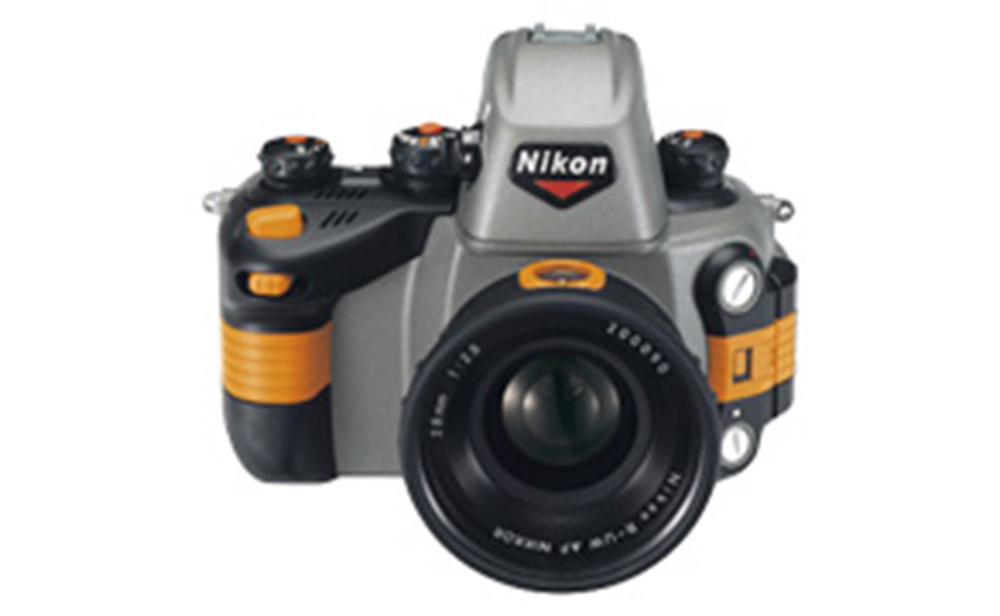
Following the first introduction of NIKONOS in 1963, several improvements were made which enabled us to offer our all-weather camera NIKONOS V (Five) (April 1984); during those years, the automatic exposure control and Speedlight made remarkable progress. In practice, however, underwater photography often entails close-up shots due to the lower clarity and bluish color of the water. The use of the NIKONOS series, which involved measuring the distance visually for focusing and framing through the direct optical viewfinder, required a certain level of sophisticate skills.
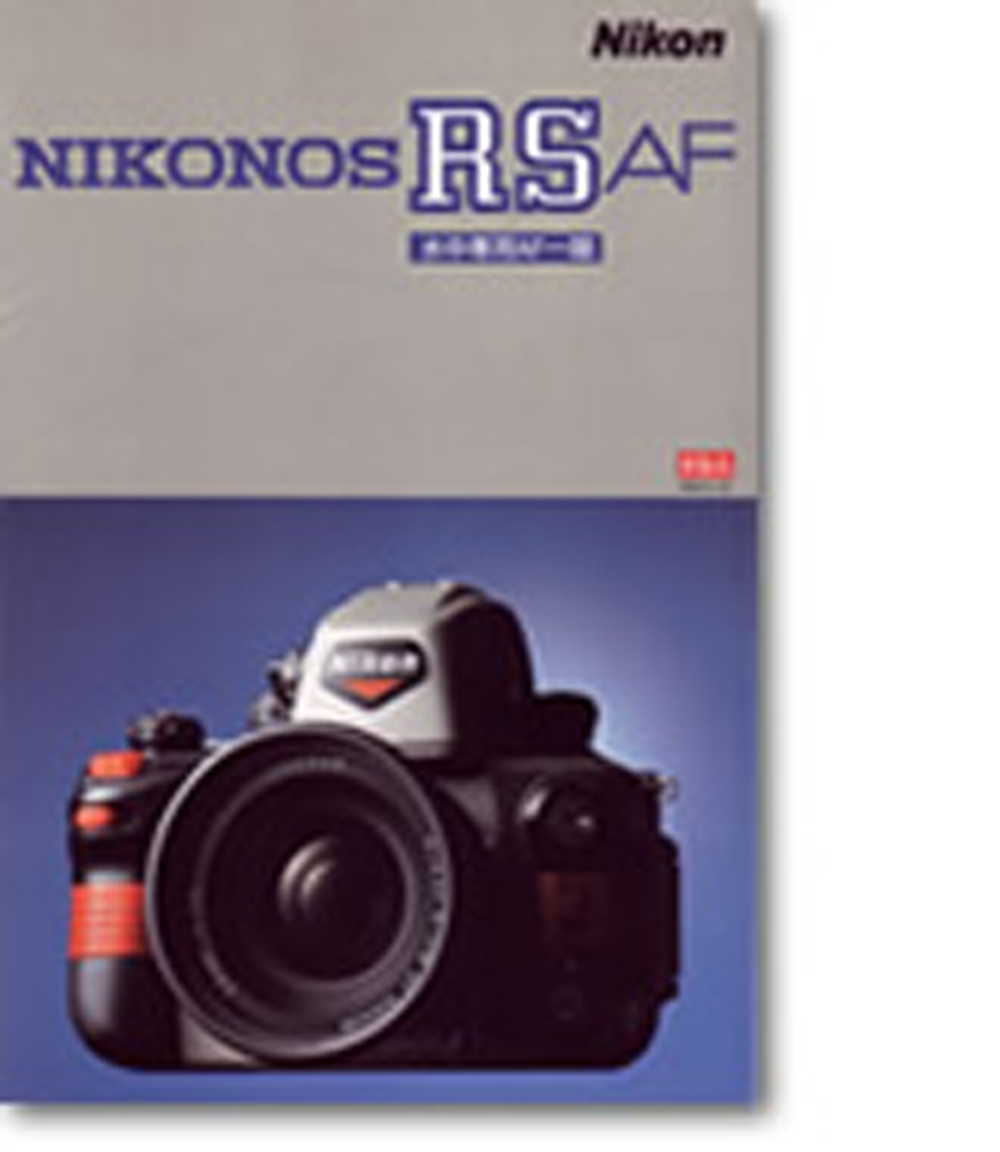
In addition, an increasing number of users requested for an authentic AF camera specifically designed for underwater photography, without a housing. Consequently, we began plans for the development of a single-lens reflex (SLR) camera to allow easy and accurate focusing and framing, and started the basic investigation in 1986. Later, we became confident that we could provide satisfactory performance underwater with advanced AF technology, and stepped forward with the commercialization of the special underwater AF SLR camera in December 1988.
The newly developed NIKONOS RS AF, which allowed AF photography in water to a depth of 100 m, was added to the lineup of our AF SLR camera series, and was exhibited as a preview at the DEMA Show (January 1992) at Houston, U.S. for diving equipment and materials, PMA Show (February) at Las Vegas, and at the Diving Festival (March) and Japan Camera Show (March) held in Japan, and then released for marketing in June (body alone at the suggested retail price of 390,000 yen, consumption tax excluded).
However, the RS, which aimed to be the ideal underwater camera, required too many processes in manufacturing, and regretfully sale was discontinued in August 1996.
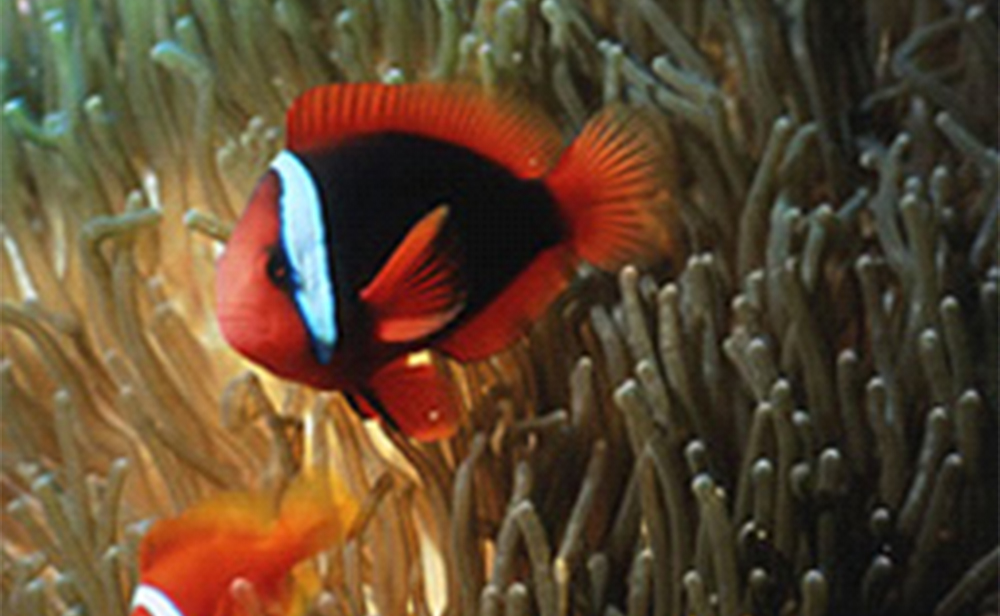
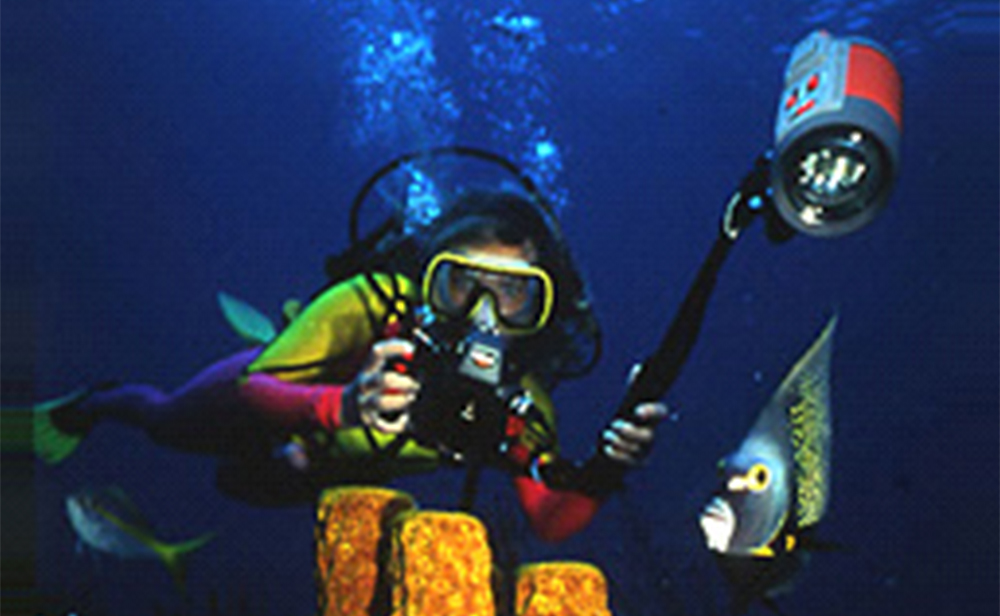
Key Features of NIKONOS RS AF
1. World's first underwater Auto-Focus SLR camera
In the NIKONOS series, focusing involved the manual setting of the distance measured visually, even though the RS implemented accurate focusing based on an automatic focusing system simply by pressing the shutter release button halfway down, similarly to typical land-use AF SLR cameras. This facilitated taking close-up shots with Auto Focusing, which conventionally had been difficult to do. In addition, as the SLR camera permits checking the images through the lenses, this model ensured more accurate framing compared to conventional framing through the direct optical viewfinder. Moreover, the viewfinder with a high eye point relief of 60 mm and a parallax of approx. 9 degrees made viewing easier even when wearing an underwater mask, therefore it was highly valued.
2. Matrix Metering
In Matrix Metering, a finder image is separated into five (5) segments and the brightness in the individual segments is comprehensively evaluated to provide the optimum exposure value. This Matrix Metering system resulted in photographic images similar to those perceived by the eye, even in backlit or complicated lighting conditions. In addition, the Matrix Metering could be switched to center-weighted metering as necessary.
3. Aperture-priority AE and manual exposure control
This model was equipped with both exposure control capabilities: aperture-priority AE to allow automatic control of shutter speeds simply by selecting an f-stop number on the aperture ring of camera, and manual exposure control to allow manual control of aperture and shutter speed.
4. Water pressure resistant up to a depth of 100 m
The conventional NIKONOS series models were designed to remain watertight up to a maximum depth of 50 m, but the RS was capable of taking photographs at a water depth of 100 m, which made this model more reliable.
5. Ultimate simplicity of operation
The model allowed selection of aperture, shutter speed, exposure compensation and shooting mode with the respective dials on the top of the body. In addition, with the adoption of the automatic focusing system, manual focusing with motor-driven power focusing was available simply by turning the focusing knob clockwise or counterclockwise. The lens range marker and frame counter were equipped with LED illumination to improve visibility. Moreover, easy film loading and automatic film wind-up and rewind were added. All basic settings could be done with the left hand, and the profile of the body was based on a form seeking ultimate simplicity of operation. Furthermore, the exterior design had a real presence; in the hands of Giorgetto Giugiaro, the famous Italian car and industrial designer, the body was shaped into a coherent design from body to lens and Speedlight, including the color ring, providing a quite different image from that of predecessor underwater cameras.
6. Unique compatible lenses
Four compatible lenses were made available, R-UW AF Nikkor 28 mm F2.8 (98,000 yen), R-UW AF Micro Nikkor 50 mm f/2.8 (165,000 yen), R-UW AF Zoom-Nikkor 20 - 35 mm f/2.8 (410,000 yen), and R-UW AF Fisheye Nikkor 28 mm f/2.8 (240,000 yen). The fisheye lens, zoom lens, and other unique lenses, which were not available in the lineup of conventional lenses for underwater photography till then, contributed to expand photographic expressions. The RS adopted the specifically designed R-UW lens mount.
7. Multi-function Speedlight
The multi-function underwater Speedlight SB-104 was also made available with a high-intensity flashlight, an illuminating angle of 100 degrees, and water tightness to a depth of 100 m. It permitted Matrix Balanced Full-Flash speedlight control when used with the concurrently released RS, and the flash remote, slave sensor and slave mode to trigger it with another strobe, and many other features gained considerable popularity.
Specifications of NIKONOS RS AF
| Type of camera | Electronically controlled motor driven 35 mm focal-plane shutter AF SLR underwater camera |
|---|---|
| Depth at which it is water pressure-resistant | 100 m |
| Lens mount | NIKONOS R-UW mount |
| Compatible lens | R-UWAF Nikkor lens (Dedicated AF lens for underwater NIKONOS RS camera) |
| Viewfinder | High eye-point action type (Offset angle approx. 9°) Eye point: Approx. 60 mm Focusing screen: Dedicated B type (Clear matte screen II; focus frame provided; not interchangeable) Finder coverage approx. 92%; Approx. 0.39x magnification (in the water, with use of 28 mm lens, at infinity (∞)) |
| Focus mode | Single AF Servo (S), Continuous AF Servo (C), Power Focus (P), Focus Priority (F) |
| Auto focus detection system and range | Type: TTL phase difference detecting method Detection system: Nikon Advanced AM200 autofocus module Detection range: EV minus (-) 1 to 19 (ISO 100); Focus Tracking with Lock-On when a moving subject is detected (in Continuous-Servo autofocus mode) AF lock: Available in Single-Servo autofocus mode |
| Exposure metering | Type: TTL exposure metering at open aperture; Aperture-priority auto (A) mode: 5-segments Matrix metering Manual mode: Center-weighted metering Metering range: EV 3 to 20 (ISO 100) |
| Exposure control | Aperture-priority auto (A) and manual (M) |
| Exposure compensation | Within ±2EV in 1/3 EV step |
| Aperture control | Aperture synchronized lever provided on the body (F2.8 to F22) |
| Film speed range | ISO 25 to 5000 for DX-coded film |
| Manual film speed setting | ISO 6 to 6400 |
| Film loading | Forward easy loading; Film automatically advances to first frame when shutter release button is depressed once after film loading: stops automatically |
| Film advance | Film automatically advances one frame due to the built-in motor when shutter is released |
| Frame counter | Direct-reading counter of automatic reset and additive type; counts back while film is rewinding; illuminated by LED |
| Film rewind | Automatic film rewind due to the built-in motor when film rewind lever is turned; approx. 25 sec. per 36-exposure roll; stops automatically when film is rewound |
| Shutter | Type: Electronically controlled vertical-travel focal-plane shutter |
| Shutter speed | From 1/2000 sec. to 1 sec.; B setting available |
| Flash sync. | Contact: X-sync only (semiconductor type) |
| Flash sync. control | 1/125 sec. or slower speeds (shutter is automatically set to 1/125 sec. when set between 1/250 sec. and 1/2000 sec. with SB-105, 104, 103, or 102) |
| Speedlight control | Type: TTL automatic flash sync. control (when used with SB-105, 104, 103 or 102) |
| Flash sync. control | Matrix Balanced Full-Flash. (in aperture-priority auto (A) mode) /TTL sync. (in manual exposure mode) |
| Sync. mode | Selective between front-curtain sync and rear-curtain sync (selected via switch inside body) |
| Camera back | Hinged type double camera back design with inner camera door (not dismantled); inner camera back provided with film checking window |
| Power source | One 6 V lithium battery pack (DL223A or CR-P2 type) |
| Power source switch | Power source is set ON when shutter dial is at any setting other than L, and shutter release button is half-pressed (Power source is automatically set OFF approx. 16 sec. after shutter release button is released) |
| Battery check | Possible when shutter speed/mode selector dial is at any setting other than L, shutter release button is half-pressed, and shutter release button is released; LED blinks for approx. 16 sec. to indicate correct battery installation and sufficient battery power; LED goes off immediately to indicate battery power is exhausted; All displays blink or fail to light up to indicate the necessity of battery replacement. |
| Dimensions (W x H x D) | Approx. 196 x 151 mm x 85 mm (Body alone) |
| Weight (on land) | Approx. 2,130 g (Body alone, without the batteries) |
Summary
NIKONOS series cameras had been used regularly for approx. 40 years by many underwater photographers. In addition, the cameras were used also on land under bad weather conditions or at locations exposed to water spray. There is an interesting story in Japan that a newspaper company used NIKONOS in beer-pouring parties in celebration of the championship of professional baseball teams, since ordinary single-lens reflex cameras would get wet and fail to take pictures.
There has been no rival product introduced by competitors for many years. This may be attributed not only to the fact that underwater cameras are distinctive in all aspects, but also to the fact that Nikon has a high degree of engineering expertise regarding all processes from design and development through to manufacturing and servicing. In addition, the waterproof capability and the excellent integration of compatible lenses, Speedlight, and a variety of accessories as a system has supported the NIKONOS series cameras.
However, in the field of underwater photography, the method for taking pictures with a land-use single-lens reflex camera enclosed in a water pressure-resistant casing, or housing, has been steadily evolving, and is currently in vogue. This was one of the factors causing the NIKONOS to be discontinued. Nikon introduced a housing 50 years ago, in 1956, which housed the Nikon S2 for underwater photography. This provides a contrast between our underwater housing, which was developed earlier and discontinued, and the currently prevailing housing-based underwater photography, which has survived for several years.
Camera Chronicle
Archives of corporate history subject matter related to Nikon cameras, including rare materials, as well as product photos of cameras and lenses.
